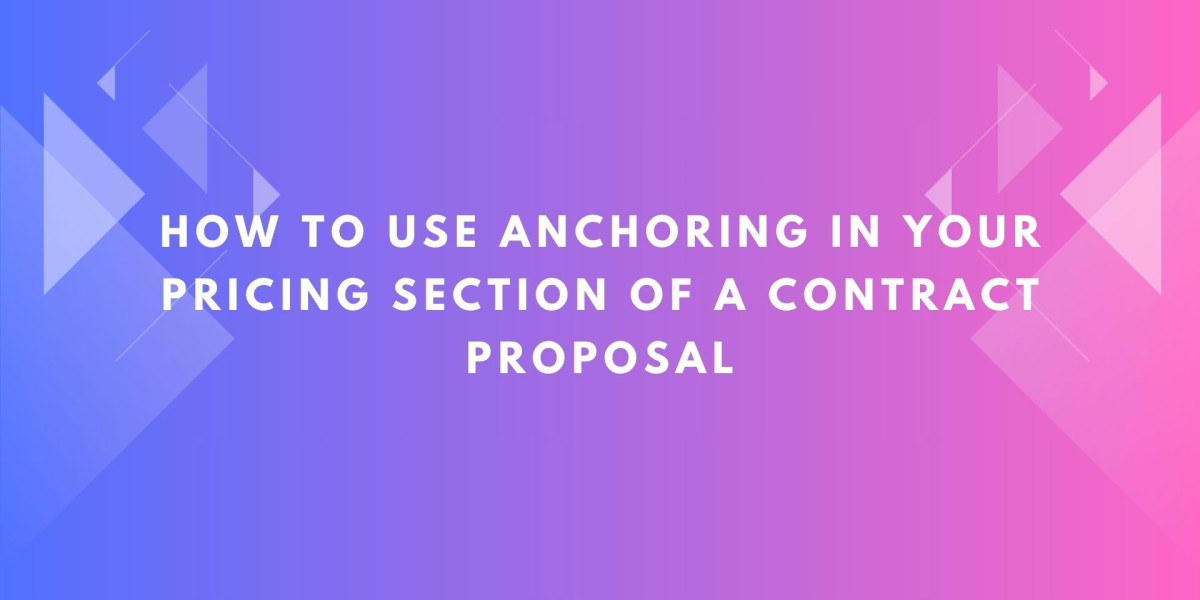Pricing is one of the most sensitive parts of any business deal. It can make or break your chances of closing a contract. When preparing a contract proposal, you want to present your pricing in a way that feels fair, competitive, and valuable to the client. One of the most powerful techniques to achieve this is anchoring. Anchoring is a psychological principle that helps you guide the client’s perception of price by setting a reference point. When used thoughtfully, it can help you position your services as high-value and make your preferred pricing option more appealing.
In this blog, we will explore what anchoring is, how it works in the context of a contract proposal, and practical ways to apply it in your pricing section to close more deals.
What Is Anchoring in Pricing?
Anchoring is a concept from behavioral economics that refers to the human tendency to rely heavily on the first piece of information they see—the anchor—when making decisions. In pricing, this means that the first figure a client sees will influence how they judge the value and fairness of your other pricing options.
For example, if you present a premium package first at $10,000, a standard package at $7,000 may seem more reasonable and attractive than if you had only presented the standard option on its own. The premium package sets the anchor, and the client subconsciously uses that as a comparison point.
Why Anchoring Works in a Contract Proposal
When a client reviews your contract proposal, they often do not have a clear idea of what your services should cost. They are looking for clues in your document to decide whether your pricing is fair and whether they are getting good value. By using anchoring, you help frame the discussion and lead the client to see your preferred pricing option as reasonable and worth the investment.
This approach works especially well in proposals that offer multiple packages, service levels, or optional add-ons. It helps clients feel that they are in control of their choice, while guiding them toward a solution that benefits both sides.
How to Use Anchoring in Your Pricing Section
1. Offer Multiple Packages with a Clear Anchor
One of the most straightforward ways to use anchoring is to present three pricing options:
A premium, all-inclusive package
A standard package that covers what the client needs most
A basic package with minimal features
The premium package sets the high anchor. When clients see the standard option next, it feels like better value because it is cheaper than the premium, yet still offers most of what they need. The basic package provides a lower anchor that makes the standard option look like the sweet spot.
In your contract proposal, you could present it like this:
Premium Package – $10,000
Includes full-service delivery, priority support, additional features, and extended warranties.
Standard Package – $7,000
Includes core services, standard support, and basic warranties.
Basic Package – $5,000
Covers essential services only, with limited support.
2. Position Your Preferred Option in the Middle
Studies show that people tend to avoid extremes. When presented with three options, clients are often drawn to the middle option. This is called the compromise effect. By setting your preferred package as the middle option, you increase the likelihood that clients will choose it.
3. Emphasize Value Differences Clearly
For anchoring to work, clients need to see what justifies the price difference between packages. In your contract proposal, use clear descriptions, charts, or tables that show what each package includes. Highlight the added benefits of the higher-priced options so that the anchor price feels justified.
For example:
Our premium package includes 24/7 emergency support and priority scheduling to ensure minimal downtime. These features are ideal for businesses that require continuous operation and peace of mind.
4. Use Visual Design to Guide Focus
In your pricing section, use layout and design to make the premium package (your anchor) stand out. This could be as simple as putting it first on the page or using a slightly larger heading or border. Then, present your preferred option right next to it so that the comparison is easy to make.
5. Avoid Overcomplicating the Options
While anchoring works well when you offer a few clear choices, too many options can confuse clients and reduce the power of the anchor. Keep it simple. Three well-defined packages are usually enough to create a strong anchor and guide decision-making.
6. Combine Anchoring with Payment Flexibility
Sometimes clients are drawn to the standard or premium option but feel concerned about upfront costs. In your contract proposal, consider combining anchoring with payment flexibility. For example, you could offer installment plans or phased billing. This makes the higher-value options more accessible.
7. Be Ethical and Transparent
Anchoring should never be about manipulating the client or inflating prices unfairly. The anchor price should reflect a real, valuable offering. The goal is to guide perception and help clients make informed choices—not to trick them into spending more than they should.
Benefits of Anchoring in Contract Proposals
When done thoughtfully, anchoring offers several advantages:
Helps clients see value: Clients are more likely to view your preferred option as reasonable when it is framed between higher and lower choices.
Encourages upsell opportunities: Some clients may choose the premium package when they see the full value it offers.
Makes pricing conversations easier: Anchoring helps set expectations and reduce sticker shock.
Supports client confidence: Offering options makes clients feel they have control and can choose what fits their needs.
Conclusion
Anchoring is a powerful tool that can help you present pricing in your contract proposal in a way that highlights value and encourages clients to choose the option that is best for both of you. By setting the right reference point, using thoughtful design, and offering clear value differences, you can guide clients toward decisions that close deals and build trust.
If you would like help designing an anchored pricing table or writing proposal language that supports this strategy, feel free to ask. Smart pricing presentation is one of the most effective ways to win more business.








